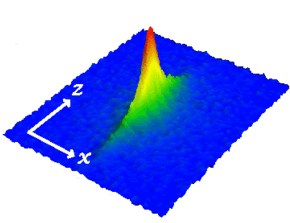
By Hamish Johnston
California might be suffering a punishing drought, but a tiny corner of the Golden State is now the coldest place on Earth. This tiny super-cold patch was created at Stanford University by Mark Kasevich and colleagues, who have used “matter-wave lensing” to cool a cloud of about 100,000 rubidium atoms to less than 50 pK. That is just 50 × 10–12 degrees kelvin above absolute zero.
The temperature of a cloud of atoms is defined by the average velocity of the atoms as they drift about. Kasevich’s team used a series of lenses to reduce this average motion to less than 70 µm/s, which corresponds to 50 pK. This shatters the previous record of 1 nK for matter-wave lensing and represents “record-low kinetic temperatures” according to Physical Review Letters, where the research is described.
So is this the coldest temperature ever achieved? A quick scan through the literature reveals that back in 2011, Wolfgang Ketterle and colleagues at the Massachusetts Institute of Technology managed to cool an optical lattice of rubidium atoms to about 350 pK using a magnetic technique. Meanwhile, Pertti Hakonen and colleagues at Aalto University in Finland managed to cool nuclear spins in a solid sample to a chilly 100 pK in 2010, but one could argue that is only one degree of freedom and not the same as cooling a gas. I have seen mentions of other sub-100 pK cooling achievements, but have not been able to track down the relevant publications.
If you know of anyone who has managed to cool a gas to about 50 pK, please let us know by leaving a comment below.



